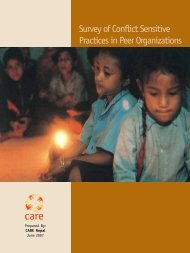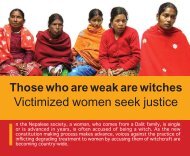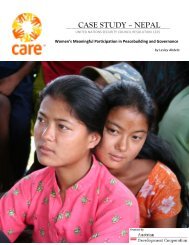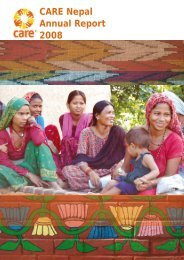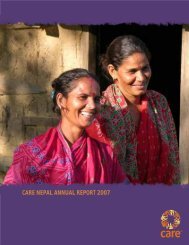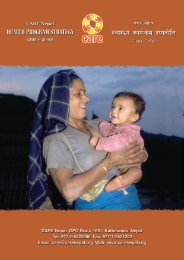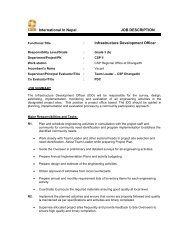Untitled - Care Nepal
Untitled - Care Nepal
Untitled - Care Nepal
Create successful ePaper yourself
Turn your PDF publications into a flip-book with our unique Google optimized e-Paper software.
Methodology<br />
The research was conducted in four<br />
districts Chitwan, Makawanpur,<br />
Sarlahi and Mohattari situated in<br />
Churia range of central <strong>Nepal</strong> where CARE<br />
<strong>Nepal</strong> has implemented women<br />
empowerment (SAKCHAM) project. Two<br />
VDCs from each district were randomly<br />
selected for the data collection. In Chitwan,<br />
Gardi and Ayodhyapuri, in Makwanpur<br />
Phaparbari and Chattiwan, in Mahottari,<br />
Bardibas and Maisthan/Khaimara, in Sarlahi<br />
Bhaktipur and Hariwan selected for the<br />
study. The selection criteria were a)<br />
population size affected with conflict, b)<br />
place where explosions/cross firing<br />
happened, c) majority of landless people,<br />
d) area where several people where killed<br />
and e) situated near the highway line. Almost<br />
one month was taken to complete the data<br />
collection process.<br />
RESEARCH<br />
OBJECTIVES<br />
The objectives of the research were to<br />
identify the psychosocial issues of women<br />
raised due to the armed conflict; and the<br />
locally available resources that women<br />
commonly use to overcome, or cope with,<br />
problems. At the same time, the research<br />
explored the link between psychosocial<br />
well-being and empowerment of women.<br />
The research was intended to collect the<br />
information over five major research<br />
questions;<br />
1. What are the psychosocial issues of<br />
women in the community?<br />
2. How did the conflict impact on the<br />
psychosocial well being of women?<br />
3. What are the different coping<br />
methodologies that women use to<br />
address their psychosocial problems.<br />
4. What are the social structures and<br />
cultural practices of the community that<br />
support or negatively impact women in<br />
their empowerment?<br />
5. How do community people perceive<br />
existing psychosocial programming?<br />
RESEARCH TEAM<br />
Four research assistants were employed for<br />
the data collection. Two male and two<br />
female, qualified and experienced<br />
researchers led by a Research Team Leader<br />
were responsible for collecting qualitative<br />
information using different qualitative tools.<br />
Development of study tools, pre-test of<br />
tools and interpretation of data and<br />
preparation of report was carried out jointly<br />
by the team members of CARE and TPO.<br />
TRAINING<br />
Five days intensive training was provided<br />
to research assistants. The training, included<br />
research methods, ethical issues, data<br />
collection methods and role play. The<br />
research team including the team members<br />
from CARE <strong>Nepal</strong> went to the Chaimale<br />
10<br />
Psychosocial Issues of<br />
Women affected by conflict



